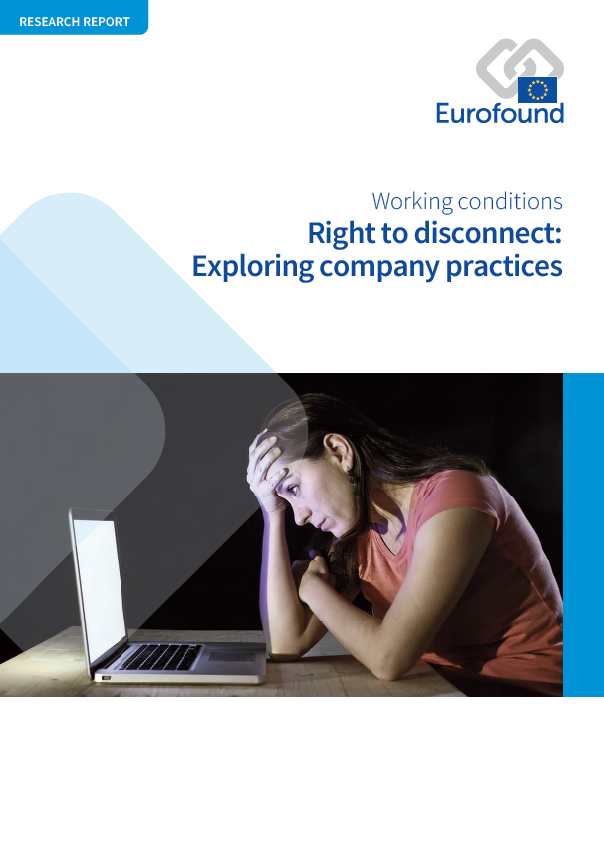
Цифровите технологии позволиха на много служители да извършват работата си по всяко време и навсякъде, с произтичащите от това предимства и недостатъци. Данните на Eurofound показват, че е два пъти по-вероятно работещите от разстояние да превишат 48-часовото работно време, да не почиват достатъчно и да работят в свободното си време, което има последици върху тяхното физическо и психическо здраве. За справяне с този проблем бяха отправени призиви за „право на откъсване от работната среда“. Настоящият доклад се основава на анализи на конкретни случаи, които очертават прилагането и въздействието на правото на откъсване от работната среда на работното място. Той се основава на предишни проучвания на Eurofound, които показват увеличение на колективните трудови договори, предвиждащи право на откъсване от работната среда в държавите, които са заложили това право в своето законодателство. След осезаемия растеж на дистанционната работа, предизвикан от пандемията от COVID-19, постигането на по-добър баланс между възможностите и предизвикателствата, свързани с дистанционната работа и основаната на ИКТ гъвкава работа, придоби по-голямо значение от всякога.
Key findings
Home-based teleworkers are twice as likely to exceed the 48-hour working time limit as workers onsite and are significantly more likely to work in their free time. Following the shift to telework during the pandemic, this is likely to lead to more hybrid working arrangements in the future, putting the spotlight on whether existing labour legislation is fit for purpose.
The experience of the first four Member States that have introduced rules and agreements on the right to disconnect prior to 2021 has demonstrated the pivotal role of the social partners in ensuring these rules are translated into reality on the ground. In countries with weaker industrial relations, legislation can provide a fallback option to ensure minimum standards are met.
The introduction of the right to disconnect in companies has revealed that a ‘soft’ approach through awareness raising, training and the management of out of hours connection is more common than a ‘hard disconnection’, which severs access to company communication during specific times.
New agreements and texts addressing the right to disconnect will need to consider the issues that lead to the ‘perceived’ need for constant connection, such as workload, lack of training and work processes that feed overconnection. High-level buy-in and regular reinforcement of the message on the importance of the right to disconnect will be critical for its success.
Although evidence of the impact of the right to disconnect on employee health and well-being, work–life balance, gender equality and company performance is lacking, social partners’ experiences at company level suggest that positive changes in company culture are taking place following the introduction of the right to disconnect.
The report contains the following lists of tables and figures.
List of tables
Table 1: Main opportunities and risks of ICT-based mobile work for work and employment
Table 2: Reasons for an absence of debate on the right to disconnect, mid-2020
Table 3: Case study companies and dates of texts containing the right to disconnect
Table 4: Dates, titles, nature, signatories, scope and coverage of the texts analysed
Table 5: Modalities and key features of connection and disconnection
Table 6: Main approaches to monitoring used by case study companies
Table 7: Qualitative and quantitative evidence gathered on implementation and impact of the right to disconnect
List of figures
Figure 1: Teleworking during the pandemic, July 2020 (%)
Figure 2: Share of employees in different ICT-based flexible arrangements working in their free time daily or weekly, 2015 (%)
Figure 3: Experience of teleworking and working hours during the COVID-19 pandemic, July 2020 (%)
Figure 4: Share of emails received outside of regular working hours that were addressed immediately (%)
Figure 5: Preferences regarding telework post pandemic by teleworking status, July 2020 (%)
Figure 6: Right to disconnect and status of legislation and debate in EU Member States, mid-2021
Figure 7: Key elements of hard and soft approaches to disconnection
- Number of pages
-
70
- Reference nº
-
EF21049
- ISBN
-
978-92-897-2186-8
- Catalogue nº
-
TJ-05-21-238-EN-N
- DOI
-
10.2806/748556
- Permalink
Cite this publication
Eurofound (2021), Right to disconnect: Exploring company practices, Publications Office of the European Union, Luxembourg.